Visiting the ancient town of Hoi An, a small and peaceful town nestled alongside the Hoai River, tourists will have the chance to explore some very famous historical landmarks, and it’s impossible not to mention the Fukian Assembly Hall (Hoi Quan Phuc Kien) in Hoi An. Originally built by Chinese merchants, this place has now been meticulously renovated and refurbished. It has played a part in creating a new, vibrant, and more attractive appearance for the ancient town of Hoi An.
Table of Contents
Fukian Assembly Hall (Hoi Quan Phuc Kien) in Hoi An – Where is it and what’s worth visiting?
- Address: 46 Tran Phu Street, Cam Chau, Hoi An City, Quang Nam.
As a religious and cultural heritage site in Hoi An, the Fukian Assembly Hall (Hoi Quan Phuc Kien), also known as Phuoc Kien, is recognized as a beloved stop for tourists. It’s a place of worship, ancestral veneration, and a meeting point for Phuc Kien people. The assembly hall boasts a unique architectural style and provides a profound experience. If you have the opportunity to visit, you should spend some time here to truly appreciate its special significance and value.
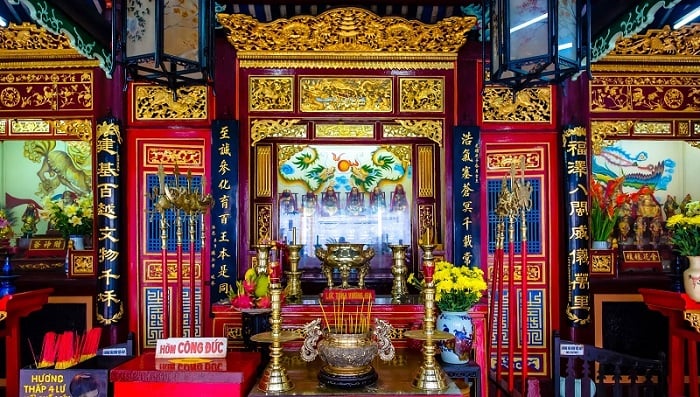
Fukian Assembly Hall is one of the three most famous assembly halls still existing in the ancient town of Hoi An. It includes the Cantonese Assembly Hall, the Dương Thương Assembly Hall, the Trieu Chau Assembly Hall, and the Hai Nam Assembly Hall. Phuc Kien is considered the most beautiful assembly hall for the Chinese community in Hoi An.
On February 17, 1990, Fukian Assembly Hall was recognized as a national historical and cultural heritage site.
How to get to Fukian Assembly Hall in Hoi An.
Fukian Assembly Hall is located on Tran Phuc Street in Hoi An, which is also one of the main streets in the ancient town of Hoi An, visited by many tourists. To get here, you first need to find your way to Hoi An’s ancient town. If you’re starting from Da Nang, you can follow one of the following routes:
- Option 1: Vo Nguyen Giap – Truong Sa Street – Lac Long Quan – turn right onto Hai Ba Trung Street – turn left onto Nguyen Cong Tru Street – turn left onto Nguyen Truong To Street – continue onto Le Loi Street – turn left onto Phan Chau Trinh Street – turn right, and you will reach the Fukian Assembly Hall.
- Option 2: Le Van Hien Street – continue onto DT607 – Proceed to the Hoi An area – reach Ly Thuong Kiet Street – turn right onto Nguyen Truong To Street and follow the route as described above.
These are the most detailed directions. If you’re not confident, you can combine these directions with Google Maps for a quicker journey. In general, if you are traveling from a distance and lack experience in Hoi An, it’s a good idea to reach the ancient town first. Then, you can ask locals or fellow tourists for directions.
Additionally, if you are looking for a fast and safe means of transportation to Hoi An, consider booking a private car rentals service from Da Nang to Hoi An From VnCarRentals.com. With a private car rental service in Hoi An, you won’t need to worry about finding public transportation, saving time, and hassle. The service provides door-to-door transportation with basic English-speaking drivers, and you can even visit places like Marble Mountains, My Khe Beach, and more on your way to Hoi An.
When did the history of Fukian Assembly Hall in Hoi An begin?
According to some official documents, Fukian Assembly Hall in Hoi An was built in 1697 with the purpose of worshiping river deities, ancestors, wealth, and praying for favorable weather. To this day, the assembly hall has become a gathering place for Phuc Kien people who came to the land of Hoi An to live and build their careers.
In terms of its formation history, around 1649 and 1650, a significant event occurred in China. The powerful Qing Dynasty emerged after overthrowing the Ming Dynasty. Many Ming Dynasty generals, refusing to submit to the Qing Dynasty, rose in rebellion to regain their status. However, due to their weak forces and inability to mount an effective counterattack, they had to flee with their families on ships heading towards Southeast Asia.
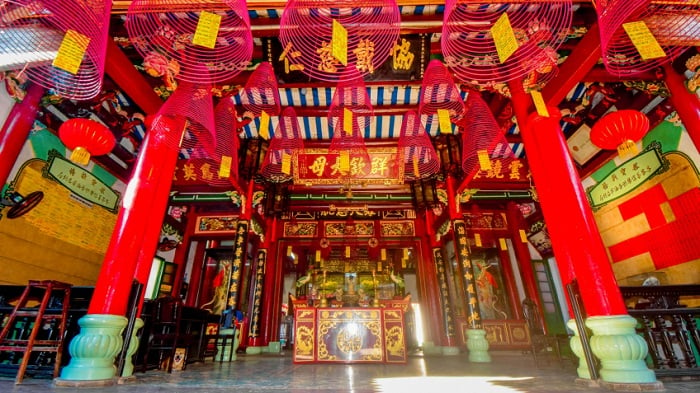
Hoi An was one of the places they stopped at, disembarking and founding the Minh Hương community. This place later became the home of people from Trieu Chau, Phuc Kien, Guangdong, Hai Nam, and Haka regions. Each region established its own assembly hall with the purpose of fostering unity and mutual support.
Today, thanks to the contributions of the overseas Chinese community from Phuc Kien, Fukian Assembly Hall has been splendidly renovated and enhanced.
Information about Fukian Assembly Hall
In Hoi An, you might not be aware of the opening hours of Fukian Assembly Hall.
Almost all historical sites and attractions in the old town have specific operating hours. They are typically open from 7:00 AM to 5:00 PM. Tourists can visit the assembly hall at any time during the day, except for evenings when it is closed.
How much is the entrance fee to Fukian Assembly Hall in Hoi An?
To visit the assembly hall, visitors are required to purchase tickets for entry. Each ticket includes access to three out of the 21 designated sites within the old town. The list of sites that require tickets includes:
- Museums: Mau Dich Pottery Museum, Folklore Museum, Sa Huynh Culture Museum, Hoi An Museum Cultural
- sites: Japanese Covered Bridge, Cam Pho Communal House, Quan Cong Temple, Trieu Tien Meeting Hall
- Churches: Tran Family Chapel, Nguyen Family
- Chapel Ancient houses: Phung Hung House, Quan Thang House, Duc An House
- Assembly Halls: Trieu Chau, Phuc Kien, Hai Nam, Dương Thương
- Japanese tombs and congregational halls of the Japanese traders
In addition, if you want to watch traditional art performances, which take place at 10:15 AM and 3:15 PM, you are required to purchase a separate ticket.
Visiting Fukian Assembly Hall in Hoi An – What’s Attractive?
Fukian Assembly Hall in Hoi An – Architecture and Spirituality
Among all the assembly halls in Hoi An, Fukian Assembly Hall is the one with the most spacious and beautiful space. In the 17th century, this structure was considered the most representative in the port city, characterized by traditional temple-like architecture with its Tam Quan gate and yin-yang tiled roof.
Originally built with wood, the assembly hall was later renovated with bricks and tiled roofs. Not only that, but the architectural details are also intricately carved and impressive. Inside the temple, there are many statues, bronze drums, bronze bells, incense burners, 14 horizontal lacquered boards, and many valuable artifacts.
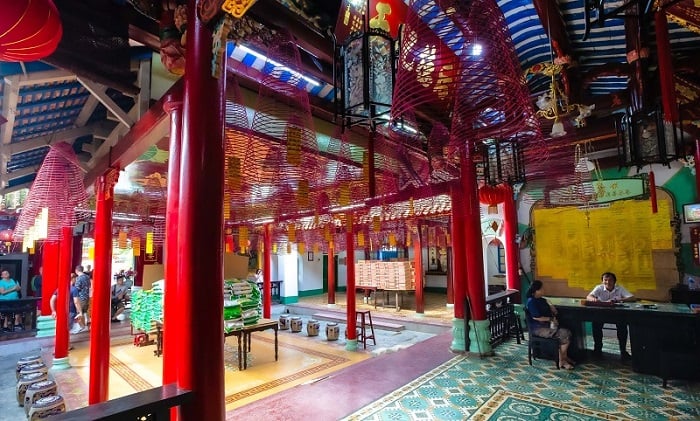
After several renovations, Fukian Assembly Hall in Hoi An has become much more complete and splendid than when it was first built. Through the construction elements and the arrangement of worship items, it reflects deep Eastern philosophies, emphasizing human happiness.
The assembly hall is not only a spiritual place for the Phuc Kien community in Hoi An but also for tourists from near and far. They come to Hoi An, passing by the assembly hall, and stop to visit the altar, praying for good health and a peaceful life. In particular, Fukian Assembly Hall is a place where those who have difficulty having children come to pray for the blessing of a child.
Check-in at Fukian Assembly Hall in Hoi An
When you visit Fukian Assembly Hall in Hoi An, apart from admiring the temple and lighting incense, you can also strike poses with the unique architecture here. Although there are restrictions on filming and photography in sacred areas, it’s not an absolute prohibition. You can take photos of the most remarkable features as a way to learn more about the heritage.
From the Tam Quan gate, the carp over the turtle’s back, the main hall, or the area with hanging incense coils are all picturesque spots. You can choose a straight-on or tilted angle depending on each frame to capture the best possible shots. With its distinctive red architecture and beautiful, harmonious landscaping, everything is sure to look exceptionally beautiful in pictures.
The Most Interesting Places to Visit at Fukian Assembly Hall in Hoi An
Tam Quan Gate
This is the entrance to Fukian Assembly Hall in Hoi An. In the past, it was also known as Kim Son Tu. On either side, you will see statues of Mr. Nhat and Mrs. Nguyet, symbolizing heaven and earth, the yin and yang. The Tam Quan gate has three entrances, symbolizing Heaven, Earth, and Human, with the south representing the male and the north the female. Usually, only the two main doors are open, while the Human door in the middle is only opened during major ceremonies.
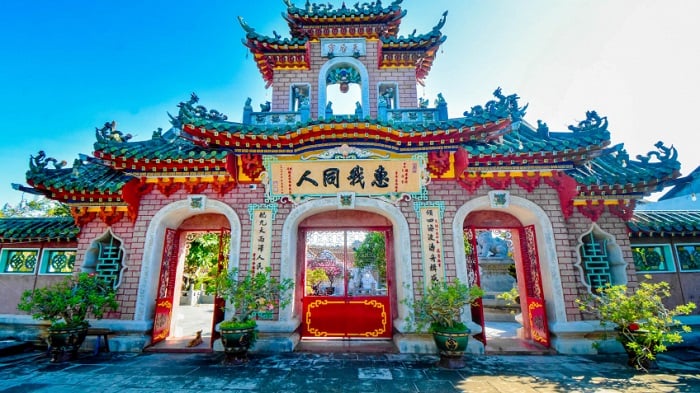
After passing through the Tam Quan gate, you will find a series of courtyards, including the front yard, back yard, a pond, the main hall, two rows of houses in the east and west, and more. Together, they create a vast space of about 3,000 square meters.
Carp Leaping Over the Dragon Gate
This is what tourists will see immediately after stepping through the Tam Quan gate. It’s a miniature landscape with the image of a carp leaping over the Dragon Gate or a carp transforming into a dragon. This is a famous legend in China, symbolizing the bringing of abundant water to the people. What makes it special is that the carp is carved in various colors, unlike the carp at the Love Bridge in Danang.
Long – Lan – Quy – Phung
In folklore, Long – Lan – Quy – Phung are collectively known as the Four Divine Beings, representing the power of the four mythical creatures of heaven and earth. They also symbolize water, fire, earth, and wind. When you visit Fukian Assembly Hall, you’ll see representations of all four of these creatures. If the dragon is a symbol of authority, the unicorn represents luck, the tortoise symbolizes everlasting existence, and the phoenix represents the celestial realm.
Large Incense Coils Inside
This is a highlight at Fukian Assembly Hall, and it’s a long-standing tradition. After visiting the hall and making contributions, visitors can write their names on large incense coils with the purpose of praying for good health and prosperity. Each incense coil like this burns for 30 days, after which the papers hanging on these coils are burned. Typically, these inscriptions contain prayers for the well-being of their families, making the ritual sacred.
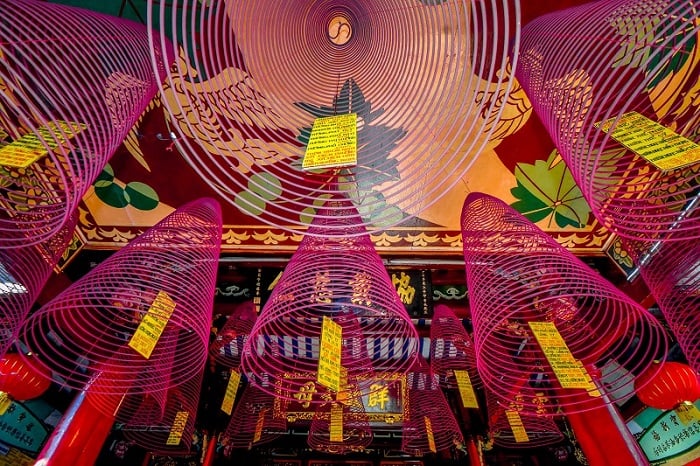
Stone Altar – Meeting Place of the Past
When you enter the ancestral altar area, you will see a green stone altar. In the past, this stone altar was a place where Phuc Kien traders gathered for meetings and discussions.
Main Hall Area
This is the main area for worshiping the Thien Hau Holy Mother, praying for her protection and the safety of the people. Thien Hau Holy Mother is not only worshiped in Fukian Assembly Hall but is a common deity in many temples in Hoi An. She is known as the goddess of the sea, providing safety to all seafarers.
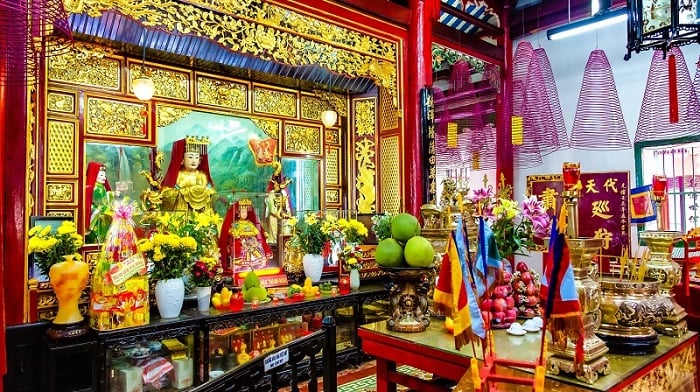
To the right of Thien Hau Holy Mother is the deity Thien Ly Nhan, who has the ability to see far and wide. To the left is the deity Thuan Phong Nhi, who has the ability to hear from afar. They are the two deities who always accompany Thien Hau Holy Mother to help all beings.
Rear Altar
This area is dedicated to the worship of the Six Lục Tánh Vương Gia, including Kham Vuong, Thuan Vuong, Truong Vuong, Hoang Vuong, Chu Vuong, and Thap Tam Vuong. These are the six leaders in the movement against the Ming Dynasty. Every year, on the 16th of February, many people come here to offer incense and pray for favorable weather.
Three Fertility Goddesses and Twelve Midwives
On the altar to the right are the deities known as the Three Fertility Goddesses. The primary deity is the one who molds the appearance of children. In addition, there are two goddesses beneath her: the goddess of birth and the goddess of death. Below them are the Twelve Midwives, each responsible for taking care of babies during one month. Therefore, in one year, a baby will develop all its natural abilities, such as speaking, smiling, and walking. The Twelve Midwives care for all the babies throughout the year.
What special festivals does the Fukian Assembly Hall in Hoi An have?
Fukian Assembly Hall in Hoi An hosts several unique festivals in addition to the well-known celebrations in Hoi An. These include:
- Le Via Luc Tanh (The Commemoration of the Six Loyalty and Righteousness Martyrs): Celebrated on the 16th of February in the lunar calendar, this festival honors the six heroes who were leaders in the movement against the Ming Dynasty. The festival includes rituals, processions, and offerings to commemorate their sacrifices.
- Le Via Ba Thien Hau (The Commemoration of Thien Hau Holy Mother): This festival takes place on the 23rd of February in the lunar calendar. Thien Hau Holy Mother is a widely revered deity who protects seafarers and brings prosperity. During this festival, worshippers offer incense and prayers to seek her blessings and protection for safe journeys at sea.
These unique festivals add to the cultural richness and historical significance of Fukian Assembly Hall in Hoi An. Visitors can immerse themselves in the local traditions and witness these special celebrations when they align with their travel dates.
Tips for Visiting Fukian Assembly Hall in Hoi An
When is the best time to check in at Fukian Assembly Hall in Hoi An?
It is known that Fukian Assembly Hall in Hoi An is open every day of the week from Monday to Friday. You can visit at any time, except for a rare time of the year when it is closed. However, based on the experience of traveling to Hoi An, it is advisable to visit on special festival days at the hall, which are the 16th and 23rd of the lunar calendar. During these times, visitors will find the hall more crowded, and the activities will be more organized and elaborate. This is also a time when Hoi An enters its dry season, from March to August every year, offering pleasant weather for sightseeing and photography.
What should you prepare when visiting Fukian Assembly Hall in Hoi An?
Apart from preparing your entrance ticket to the ancient town, there’s no need to bring anything else. If you plan to make offerings, you can purchase them inside the hall. If you wish to light incense, it is also available for purchase inside.

Additionally, it’s a good idea to plan your itinerary in advance to make the most of your visit. You can purchase tickets for the various destinations within the old town and explore the pedestrian streets first. You can explore the entire old town in one morning. Afterward, if you have more time, you can arrange visits to more distant places such as the Hoi An ancient brick kiln, An Bang Beach, Thanh Ha pottery village, Tra Que vegetable village, etc., in the afternoon.
What to Eat When Visiting Fukian Assembly Hall in Hoi An?
When planning your visit to Fukian Assembly Hall in Hoi An, you can also explore the local specialties and delicious dishes that the town is known for. Hoi An is famous for its diverse and delicious cuisine, with a unique blend of flavors. Many local dishes are both affordable and full of rich flavors, making them a must-try. Some of the popular local dishes to enjoy in Hoi An include Cao Lau, Mi Quang, Hen Xao (spicy clams), and Che Thap Cam (mixed sweet dessert), among others. These dishes are traditional and reflect the local culture, making your culinary experience in Hoi An a memorable one.

Some Tips for Visiting Fukian Assembly Hall in Hoi An
Fukian Assembly Hall, like other spiritual sites in Hoi An, has specific guidelines for visitors. While you may have a ticket for admission, it’s essential to be mindful of the following tips:
- Dress appropriately: Ensure your attire is not revealing, and while it doesn’t need to be overly formal, it should be respectful. This shows your cultural sensitivity and respect for the deities at the site.
- Walk gently: Maintain a composed and quiet demeanor. Avoid laughing, joking, or making disruptive gestures to preserve the solemn atmosphere of the hall.
- No food or drinks: Refrain from bringing food or beverages into the assembly hall to maintain the sacred atmosphere and keep the premises clean.
Hoi An’s various assembly halls, including Fukian Assembly Hall (Hoi An Phuc Kien), contribute to the town’s unique cultural heritage and appeal. With their distinctive architectural styles set within the peaceful, ancient ambiance of Hoi An, these assembly halls are a significant part of any traveler’s Hoi An experience.


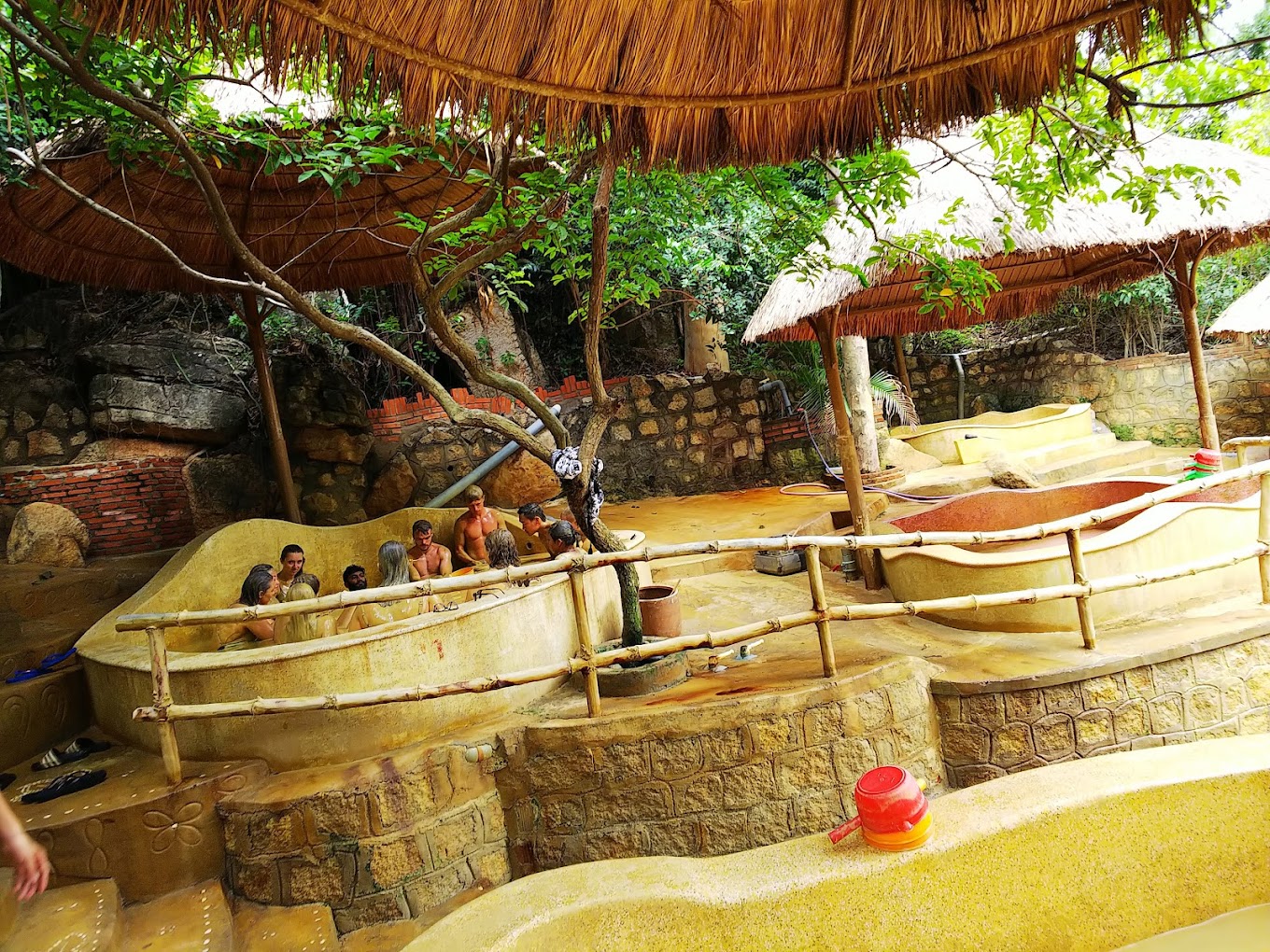
[…] Fukian Assembly Hall (Phuc Kien) is a popular destination for many tourists in Hoi An. It was built in 1967 with the purpose of praying for good health, favorable weather, and children. […]